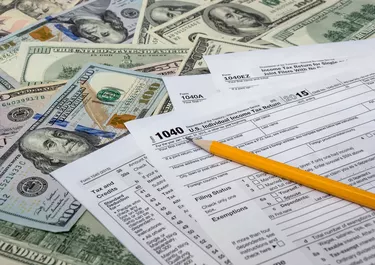
When you're entitled to a distribution from a retirement account, such as an IRA, you have an option as to how you take your money. If you take everything out all at once, that withdrawal is known as a lump sum distribution. Since distributions from nearly all retirement accounts are taxable, you'll owe ordinary income tax on the amount you take out. However, if you qualify for special lump sum distribution treatment, you may be able to save on the amount of tax you owe.
Qualifying for Lump Sum Treatment
Video of the Day
The IRS offers special tax treatment on lump sum distributions for account holders born before January 2, 1936. This special treatment applies only on distributions due to death, separation from service, after attaining age 59 1/2 or after becoming totally and permanently disabled as a self-employed individual.
Video of the Day
If you qualify for lump sum treatment, the IRS offers you five options for how to calculate your tax, with some options more complicated than others:
- report taxable gains from participation before 1974 as capital gain and those after 1973 as ordinary income;
- report taxable gains from participation before 1974 as capital gain and apply the 10-year tax treatment to those after 1973;
- use the 10-year tax option on the entire taxable withdrawal;
- roll over some or all of the distribution; or
- treat the entire taxable distribution as ordinary income.
Since capital gains tax rates are lower than ordinary income tax rates, the option of treating some of the distribution as a capital gain will lower your tax liability. The 10-year tax option is a special way the IRS offers to calculate tax on part of your distribution which can result in a lower tax liability.
If you roll over your distribution to a qualified retirement plan, such as an IRA, you won't have to pay tax on the transfer. However, you'll ultimately be liable for taxes if you withdraw from the rollover account.
Calculating Taxes
You'll calculate the taxes on your lump sum distribution using IRS Form 4972 and the information on the Form 1099-R that will be sent to you by the financial institution handling your distribution.
If you elect the capital gain treatment, the amount listed as a capital gain in box 3 of your 1099-R will be taxed at 20 percent. The remainder of the income listed on your 1099-R will be taxed at your ordinary tax rate. For example, if you have a $100,000 lump sum distribution, $40,000 of which is listed as a capital gain, and you're in the 25 percent tax bracket, your tax on the distribution will be $23,000, calculated by adding $8,000 (your $40,000 capital gain times 20 percent) plus $15,000 (your remaining $60,000 income times 25 percent). This combined rate of $23,000 is lower than the $25,000 you would pay if your entire distribution was taxed at your ordinary income tax rate.
If you elect the 10-year averaging treatment, your calculations get more complicated but can be computed on Part III of Form 4972. Essentially, the benefit of 10-year averaging is that you get to treat your distribution as if it were paid out over 10 smaller payments, rather than in one large lump sum. You may end up paying lower tax in this scenario because taking a large taxable distribution all at once could push you into a higher tax bracket. If you instead treat the distribution as if it were paid over 10 years, the smaller amounts may keep you in a lower tax bracket.
One of the caveats of 10-year averaging is that you'll have to use 1986 tax brackets to compute your taxes. In that year, if you had a taxable income of $50,000, you'd be in the 33 percent bracket if you were married filing jointly. With a $100,000 lump sum distribution, you'd take 10 percent, or $10,000, and add it to your taxable income. Your resulting taxable income of $60,000 in 1986 would still have you in the 33 percent bracket. Your tax for your lump sum would therefore be $33,000 ($10,000 times 33 percent = $3,300 times 10 equals $33,000). To determine whether 10-year averaging makes sense for you, you'd have to compare it to your other tax options.
Warning
Choosing the right option when it comes to qualifying lump sum distributions can be extremely complicated. Consult a tax adviser to ensure you are paying the lowest amount of tax possible.